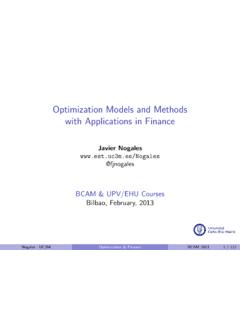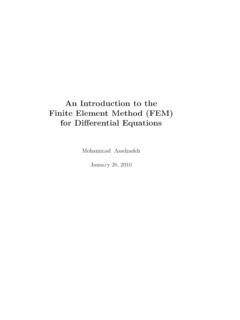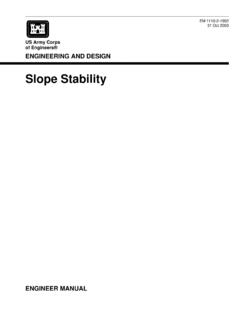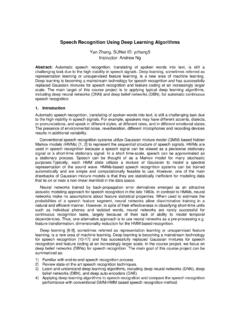Transcription of Introduction to Computational Fluid Dynamics by the Finite ...
1 Introduction to Computational Fluid Dynamicsby the Finite Volume MethodAli Ramezani, Goran Stipcich and Imanol GarciaBCAM - Basque Center for Applied MathematicsApril 12 15, 2016 Overview on Computational Fluid Dynamics (CFD)1. Overview on Computational Fluid Dynamics (CFD)2 / 110 Overview on Computational Fluid Dynamics (CFD)What is CFD?IFluids:mainly liquids and gasesIThe governing equations are known, but not their analytical solution:thus, weapproximateitIBy CFD we typically denote the set ofnumerical techniquesusedfor theapproximatesolution (prevision) of the motion of fluids andthe associated phenomena (heat exchange, combustion, Fluid -structure interaction .. )IThe solution of the governing differential (or integro-differential)equations isapproximatedby adiscretizationof space and timeIFrom thecontinuumwe move to thediscretelevelIThe CFD is deeply connected to the improvement ofcomputersinthe last decades3 / 110 Overview on Computational Fluid Dynamics (CFD)Applications of CFD IAny field where thefluid motionplays a relevant role:IndustryPhysicsMedicineArchitecture MeteorologyEnvironment4 / 110 Overview on Computational Fluid Dynamics (CFD)Applications of CFD IIMoreover, theresearch frontis particularly active:Basic research on fluidmechanics ( transitionto turbulence)Application oriented ( energy,competition.)
2 New numerical methods5 / 110 Overview on Computational Fluid Dynamics (CFD)CFD: limits and potential complex for in measurements & and interpretationof to simple linear limited to linear complex and affordable in the project : discretization, in boundary for set-up & for interpretation6 / 110 Overview on Computational Fluid Dynamics (CFD)CFD: limits and potential IICFD is closer to experimental approach:We need simplified analysis, heuristics, intuition, experience ..trial-and-error!CFD cannot (at the present) substitute experiments:IThe equations are not rigorously exact (assumptions are made)IThe continuum eq. are discretized: we would ideally need an infinitelyfine grid for perfect analogyIThere might be numerical phenomena that alter the equation sbehaviour ( numerical diffusivity)I Small scale effects are typically modelled ( turbulence,combustion .. )7 / 110 Overview on Computational Fluid Dynamics (CFD)CFD: key ingredientsBehind the term CFD there is a whole WORLD.
3 And if we try to put it into one problem:physics, industrial or research, level of accuracy .. model:2D or 3D, stationary or not, compressible or not, requiredinformation, available resources .. There isnota general purpose model! method: Finite difference / volume / element, avail. software .. mesh:Structured or not, curved .. techniques:Several choices balancing accuracy and method:Type of solver, direct, iterative .. & stability:Choice of the criteria based on accuracy and processing & interpretation:From variables field calculate and visualize whatneeded: flow characteristics, lift/drag ..8 / 110 Overview on Computational Fluid Dynamics (CFD)Outline of the courseIGoran Stipcich(Tuesday Wednesday) on Computational Fluid Dynamics (CFD) equations of Fluid motion and their modellingIAli Ramezani(Thursday Friday) and boundary and generationIImanol Garc a(Friday) session using BBIPED software9 / 110 Governing Equations and their Discretization2.
4 Governing Equations and their Discretization10 / 110 Governing Equations and their DiscretizationGoverning equationsDerivation: conservation lawSome hypothesis on Fluid Dynamics are interested in the motion of a large number of individualparticles: atoms and molecules! the density of the Fluid is high enough so that themotion can beapproximated as continuum we are in the field ofcontinuum mechanics3. An infinitesimally small Fluid element (in the sense ofdifferentialcalculus) still contains enough particles, allowing us to prescribemean quantities such as velocity, energy are thus able to define all this quantities at each point of the fluid11 / 110 Governing Equations and their DiscretizationGoverning equationsDerivation: conservation law (cont.)We thus naturally divide the flow field into Fluid elements , orvolumes, andtry to develop a mathematical description of its define thefinite control volume(fixed in space):dSn vwhere is the control volume with boundary is ,nis the outwardingunit normal vector, andvis the velocity / 110 Governing Equations and their DiscretizationGoverning equationsDerivation: conservation law (cont.)
5 Applying the conservation law to a scalar , we state that thefollowing quantities are in equilibrium within a control volume in timet:ddt d due to the velocityv(convective flux): (v n) due the diffusion (diffusive flux), expressed by thegeneralized Fick s gradient law: [ ( / ) n]dS,where is the thermal diffusivity coefficient, and is the density4. VolumeandsurfacesourcesQV,QS: QVd + (QS n)dS13 / 110 Governing Equations and their DiscretizationGoverning equationsDerivation: conservation law (cont.)After summing the contributions, we end up with the general conservationlaw for ascalar quantity:ddt d + (v n) [ ( / ) n]dS= QVd + (QS n)dS(1)14 / 110 Governing Equations and their DiscretizationGoverning equationsDerivation: conservation law (cont.)NOTE:if we consider avectoras conserved quantity, the previousconservation law (1) would still be differing in theorderof the geometrical and diffusive fluxes becometensorsFC, volume source becomes surface source becomes atensorQSWe can rewrite the conservation law for avector quantityuasddt ud + [(FC FD) n]dS= QVd + (QS n)dS(2)15 / 110 Governing Equations and their DiscretizationGoverning equationsDerivation: conservation law (cont.)
6 Equations (1) and (2) express the conservation law in theintegralformulation, and are characterized by two very important and desirableproperties:1. Conservation:in absence of sources, the variation of anduis onlydue to fluxes across the boundary , andnoflux is created inside bothlocalandglobalconservation2. Generality:the integral form remains valid even in presence ofshocks and discontinuityNOTE: Because of these properties, historically, themajority of the CFDcodes is based on the integral form of the governing equations ( AnsysFluent, OpenFOAM .. )Theintegral formis essentially thefinite / 110 Governing Equations and their DiscretizationGoverning equationsDerivation: continuity equationKeep in mind our control volume :dSn v17 / 110 Governing Equations and their DiscretizationGoverning equationsDerivation: continuity equationWe consider the conservation creation or disappear of mass (no sources or sinks) diffusive flux ( , for a Fluid at rest, a variation in mass wouldimply a displacement of Fluid ) is the conserved quantityThen, by using the conservation law for a scalar (1) on our control volume we have theintegral formof the continuity equation: t d + (v n)dS=0(3)NOTE: The positive outwarding convention in used:inflowfor flownegative flow,outflowfor positive18 / 110 Governing Equations and their DiscretizationGoverning equationsDerivation: momentum equation IIt is basically the statement ofNewton s second law.
7 The variation ofmomentum is caused by the sum of the net forces on the mass consider the conservation of themomentumin the infinitesimalportion of the control volume vd the Cartesian coordinate system, the product vhasthreecomponents v= [ u, v, w] flux tensorFChave the following three components:x: uvy: vvz: diffusive flux ( , for a Fluid at rest, a variation in momentumwould imply a displacement of Fluid )19 / 110 Governing Equations and their DiscretizationGoverning equationsDerivation: momentum equation IIWe now consider theforcesacting on the Fluid element1. External volumeorbody forces: act directly on the mass ( , buoyancy, Coriolis, centrifugal, electromagnetic)QV= fe2. Surface forces:act on the surface of the control volumeIPressure distribution: isotropic pIINormalandshearstresses due to friction:viscous stress tensor Then, by using the conservation law for a vector (2) on our control volume we have theintegral formof the momentum equation: t vd + v(v n)dS= fed + [ pn+( n)]dS(4)20 / 110 Governing Equations and their DiscretizationGoverning equationsDerivation: energy equation IIt is basically the first law of thermodynamics.
8 The change in time of thetotal energyEof our control volume is given by the rate of work done byapplied forces and by the net heat conserved quantity is thetotal energy per unit mass E, whereE=e+|v|2/2, withethe internal energy per unit we do have adiffusive fluxFD= ewhich represents the diffusion of heat due to molecular thermalconduction, where =cp/cvis the ratio of specific heat commonly we useFourier s lawFD= k Twherekis thethermal conductivity coefficient21 / 110 Governing Equations and their DiscretizationGoverning equationsDerivation: energy equation IIOther contributions to energy heat sources:Irate of volumetric heating(radiation, chemical .. ) qhIrate of workby body forcesfethus the totalrateof work by volume sourcesQV= fe v+ sources:rateof work done by pressure, and normal andshear stressesQS= pv+ v22 / 110 Governing Equations and their DiscretizationGoverning equationsDerivation: energy equation IIIM oreover, we use the relation for total enthalpyH=E+p Then, by using the conservation law for a scalar (1) on our control volume we have theintegral formof the energy equation: t Ed + H(v n)dS= k( T n)dS+ ( fe v+ qh)d + ( n)dS(5)23 / 110 Governing Equations and their DiscretizationGoverning equationsComments on viscous stresses IIf we don t consider the viscous stress tensor , wedeal withEuler equations.
9 IHyperbolic systemIPure convection in inviscid Fluid , goodapproximation in high-speed flowIUsed to describe shocks, expansion wavesITypically, base for development of discretizationmethods and boundary conditionsLeonhard Euler1707 178324 / 110 Governing Equations and their DiscretizationGoverning equationsComments on viscous stresses IIThe Fluid is considered asNewtonian:Ithe shear stress depends on thevelocity gradient ij ui/ xj,where is thedynamic viscosityIStokes introduced the hypothesisfor thebulk viscosity +2/3 =0, where is thesecond viscosity coefficientICoefficients andkare functions ofthe state of the Fluid : in continuummechanics, these are determinedbyempirical assumptionsClaude-LouisNavier1785 1836 George Stokes1819 190325 / 110 Considerations on accuracyGoverning Equations and their DiscretizationDiscretization techniquesConsiderations on accuracy IThree typesofsystematicerrors:1. Model error:difference between the real problem and the chosenmodel equations2.
10 Discretization error:difference between the exact solution of themodel equations and the exact solution of the discretized system3. Convergence error:difference between the exact solution of thediscretized system and the solution obtained iterativelySome are dominant on the others, depending on the problem, andsometimes they can even compensate ( have a more accurate solutionon a coarser mesh)!26 / 110 Governing Equations and their DiscretizationDiscretization techniquesConsiderations on accuracy IIIf not considering analytical methods , which are only viable for fewsimplified problems, we can say that almost all numerical strategies followthesame of space:IFinite Difference (FV)IFinite Volumes (FV)IFinite elements (FE)ISpectral methods , hybrid, Boundary Element Method (BEM) .. in time:ITypically, some kind of Finite Difference method (implicit/explicitmethods .. ) get asystem of equations27 / 110 Governing Equations and their DiscretizationDiscretization techniquesForms of the governing equations I: integral formWe derived the governing system of equations in theintegral form, sinceit is naturally suited for Finite Volume discretizations: t d + (v n)dS=0(3 continuity) t vd + v(v n)dS= fed + [ pn+( n)]dS(4 momentum)+ Energy equation(5)28 / 110 Governing Equations and their DiscretizationDiscretization techniquesForms of the governing equations II: differential formHowever, we can obtain thedifferential form, for using otherdiscretizations apply the divergence theorem to surface integrals, and Leibniz integralrule for time derivative, and we get thedifferential, conservative form.









